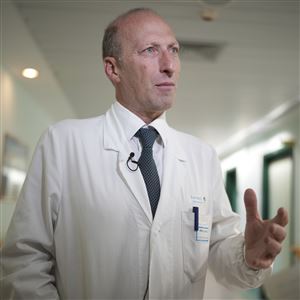Evan Crickenberger is a lively 8-year-old boy from Russellville, W.Va., who gets excited at the mention of the computer game system he used to play while he was a surgical patient at the Children's Hospital of Pittsburgh of UPMC.
"Yeah, GameCube!" he said. "I really liked that."
"He had a lot more fun than I did, for sure," said Suzann Crickenberger, his adoptive mother.
That's because Evan was in the hospital to have the entire left half of his brain removed.
For a small number of children, removing one side of the brain -- a procedure called hemispherectomy -- is the only way to prevent debilitating seizures. The procedure is not just a last-ditch chance for these children to survive. In some cases, it allows them to thrive.
This radical surgery is reserved for children with seizures that originate from only one hemisphere of the brain and don't respond to medication. They can be caused by stroke or by rare neurological disorders that cause one side of the brain to develop abnormally. Other causes include Rasmussen's encephalitis, a chronic inflammation of the brain that usually affects just one hemisphere.
The damaged tissue can trigger seizures that can spread to the rest of the brain. Removing the unhealthy hemisphere can prevent the seizures and halt the spreading, but it also causes partial paralysis of the opposite side of the body and the loss of one half of the visual field.
Normally, the right half of the visual field in both eyes is processed by the left hemisphere and vice versa.
"It's human nature to think: 'Whoa, how can we function without one half of the brain?' " said Satyanarayana Gedela, an epilepsy specialist at Children's. But the brain is remarkably adaptable, especially in children, he said.
Evan's case was unusual because his seizures were caused by physical trauma. At the age of 3, he and his birth mother were involved in an accident on a four-wheeler. Part of a tree branch entered the left side of his brain through his left eye.
"The doctors said, 'There's nothing else we can do for him,' " Ms. Crickenberger said. "All they did was open up his head and clean all the mess that they could clean out and closed him back up. They said if he lives, he lives. They said he would never walk or talk again."
In right-handed people like Evan, the left hemisphere plays an important role in language.
Ms. Crickenberger adopted Evan and his older sister when their birth mother lost custody. "They were family anyway. I'm actually their great-aunt."
Evan eventually learned to talk and to walk with a limp, although he couldn't use his right hand. The vision in his remaining right eye was restricted to just the left half of the visual field.
But the real problem was the seizures.
During a seizure, the right side of his body would jerk and he would fall. The seizures became progressively more severe, sometimes lasting as long as an hour. At one point he was having 12 to 15 seizures a day.
These were only the visible effects. Hospital tests showed traces of seizure activity in Evan's brain for much of the day, Ms. Crickenberger said.
Because Evan's seizures didn't improve with medication, his doctors tried a targeted surgical technique, in which they locate the precise source of the seizures and then remove only that part of the brain. The surgery seemed to work at first, but after six months his seizures returned stronger than ever.
The only option left was to remove the damaged hemisphere entirely. "It took them forever to even come to that decision," Ms. Crickenberger said.
The decision to remove the rest of Evan's left hemisphere was difficult because the tissue had been healthy before the accident, said Dr. Gedela. For most children facing hemispherectomy, the tissue that is removed is already damaged or is expected to deteriorate. "They were totally afraid that they would make him blind, and that was my biggest fear," said Ms. Crickenberger.
For two days after Evan's hemispherectomy in January 2011, swelling prevented him from opening his eyes. "He kept telling me that he couldn't see me," Ms. Crickenberger said. "But on the third day he woke up and he looked at me and he said, 'Hi, Mama!' "
The benefits of hemispherectomies often outweigh the risks, said Ajay Gupta, a pediatric epilepsy specialist at the Cleveland Clinic. About two-thirds of hemispherectomy patients remain free of seizures for the long term.
"That's a good number," Dr. Gupta said. "Remember, these patients are catastrophically sick. They can die if we don't do anything for them because medications don't help them."
In August, Dr. Gupta and his colleagues published a study of 115 patients who had hemispherectomies at the Cleveland Clinic between 1997 and 2009. After rehabilitation, more than 80 percent of patients were able to walk independently. Three-quarters did not consider their vision problems significant. Nearly 70 percent were able to speak fluently, although reading difficulties were common. Five of the 24 patients who were over 18 were holding down an unsupervised job.
Dr. Gupta predicts that surgeons will be less hesitant to offer hemispherectomies in the future. "We are going to be becoming somewhat more proactive, somewhat more aggressive to offer the surgery," he said. They could also be offered at a younger age, as young as 4 weeks old, he said.
Adult patients can also benefit from hemispherectomy, but because children's brains are still developing, more brain function can be taken over by the remaining hemisphere.
It is still a mystery exactly how a child's brain is able to coordinate the remapping of functions onto the other hemisphere, said Marlene Behrmann, a psychology professor at Carnegie Mellon University. "Why isn't it just mayhem in the remaining part of the brain?" she said.
Ms. Behrmann and her colleagues have begun to study visual processing in hemispherectomy patients from Children's Hospital.
They will use functional magnetic resonance imaging to test how the patients process input from different locations in the visual field and from different types of visual information, like words, faces, objects and scenes.
In the long term, scientists hope that understanding how children recover from hemispherectomy will suggest treatments for more common causes of childhood brain injury.
Evan has blossomed since his left hemisphere was removed, Ms. Crickenberger said. Before the hemispherectomy he was going to school but struggled to learn. It then took several difficult months for him to recover from the surgery. "Finally he told me: 'Mom, you're boring.' And I said: 'Boy, it's time for you to go back to school."
These days, Evan is racing to catch up to the third grade reading level and enjoys playing his computer games at home.
He and his family find ways to work around his paralysis and restricted vision. Ms. Crickenberger fixes his schoolwork to the table with tape because he can't use his right hand to hold his papers while he writes with his left hand. He also has to move his head more when reading to keep the words within his field of vision and turns his head to a slight angle when talking to people.
"But he still plays video games and watches TV and reads and does his writing by himself," Ms. Crickenberger said. Sometimes, she added, he's doing it all at once.
First Published: October 21, 2013, 12:00 a.m.
Updated: October 21, 2013, 12:10 a.m.















